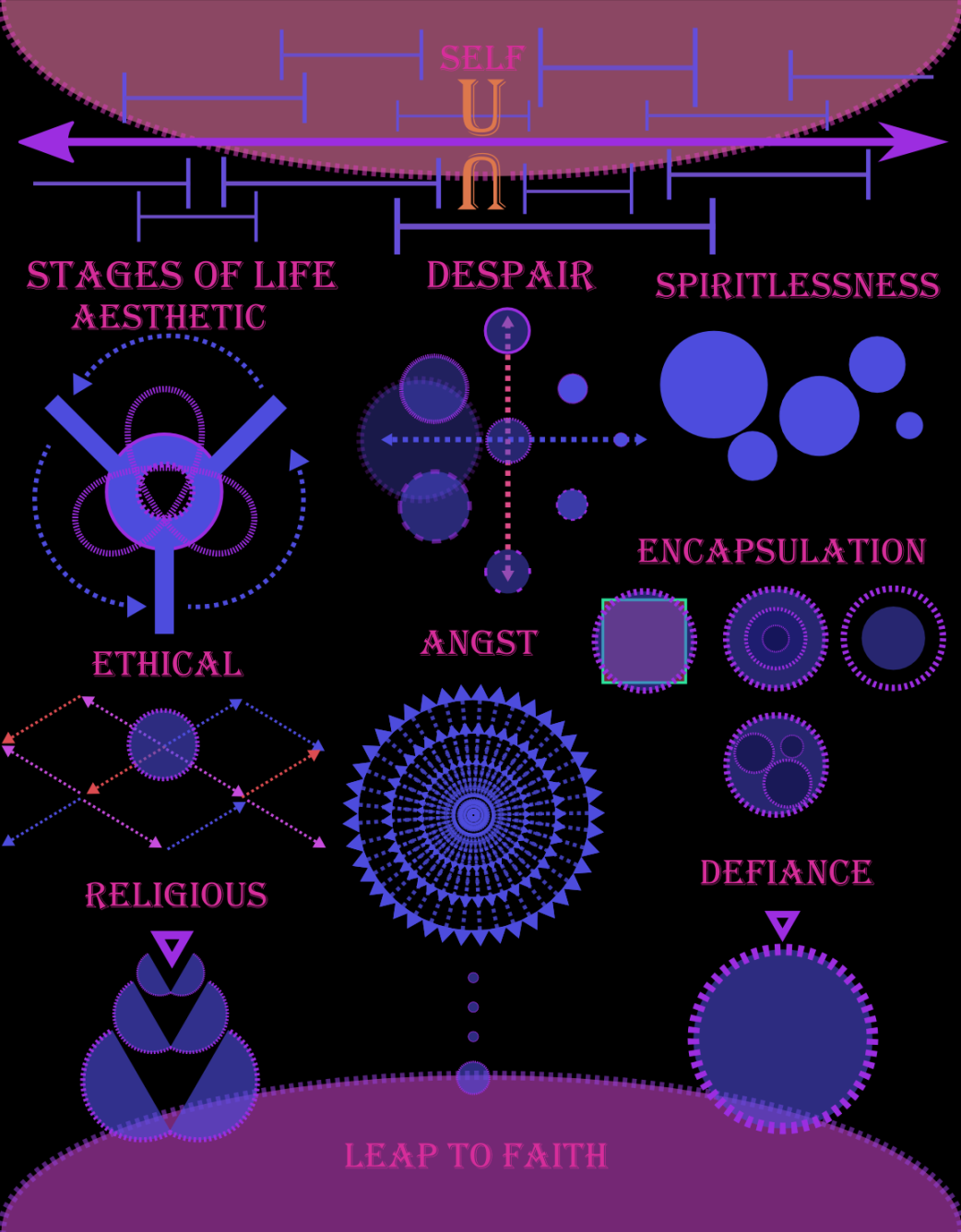Kierkegaard, the father of existentialism, equates the human responsibility of achieving self-hood (subjectivity) with truth. Kierkegaard’s notion of self is the union of acts that relate between dualities such as finite/infinite, necessity/possibility, and temporal/timeless. This is a negative space of the Hegelian synthesis of duals that moves from descriptive to prescriptive ethics. Truth or the realization of the self is known through the active choice of relating between duals without identifying too closely with either poles (failure results in forms of despair). An important case concerns the religious duality between sin/faith which is powered by the tension between Christianity’s paradox to reason and the necessity of a leap to faith. Although Kierkegaard’s process of individuation (achieving selfhood) occurred predominantly along religious lines, he introduced a number of general concepts that speaks to the human condition.
The responsibility of achieving selfhood compels one to make conscious choices at every moment. Each moment entails a great number of choices, and their multiplicity of consequences to consider lead the subject to experience a “dizziness of freedom” or angst/dread. This paralysis by analysis, or the anticipation of consequences render one immobile and unable to make a choice for fear of sin. Conversely, it is the experience of anxiety that allows one to move away from unconscious ignorance and into one’s potential for action, self-recognition, and identity.
Kierkegaard posits three existential stages of life along the way of becoming a true self:
- The aesthetic (the hedonist) lives for sensory experience and pleasure as a way to combat boredom; Boredom is characterized as “the root of all evil-the despairing refusal to be oneself” as it is an undifferentiated or an undirected state of consciousness. The aesthetes who avoid boredom through the pursuit of novelty also avoids commitments as it requires repetition. Common techniques to suspend boredom is through anticipation which delays gratification, and the so-called “rotation method” where one cycles between activities so that no one activity’s novelty is exhausted. However, the mode of living is self-serving and ultimately meaningless as it ignores the dimension of other individuals or society.
- The ethical is the antithesis of the aesthetic where one lives a life according to well-defined rules for the good of society rather than for the self. In the process acting according to higher principles, new pleasures may be realized that could not by the aesthetic. For example, while the novelty of marriage wears off, the act of giving to your spouse and children is rewarding.
- The religious is the final stage of the true self which requires a commitment to the moral absolutes of God. Such absolutes are communicated not through social institutions such as the church, but through a personal relation or revelation of God. Such absolutes require a “teleological suspension of the ethical” as they may contradict that of social norms; one may have to sacrifice pleasures of both the aesthetic and the ethical to reach this. Thus, one can consider revelation (disclosure of divine moral absolutes) as the synthesis of the pursuit of novelty (now the spiritual sphere) and the repetition of commitment (now in the subjective sphere).

Kierkegaard describes the experience along these stages of life in terms of despair that arise from an unbalanced identification with poles of duals (lack of finitude/infinitude, necessity/possibility). Three levels are given:
- The lowest level is the ignorance of one being in despair or of having a self (unconscious of self). One may be unable to realize one’s potential in life as he/she is fully in pursuit of novelty or of sensuous dichotomies of agreeable/disagreeable. He/she imagines himself happy but is actually dependent on the various objects of pleasure (materialist). Conversely, the system-builder who lives inside abstractions is divorced from experience. The system is merely a scaffold over an abyss from which the self’s relation to the concrete is hidden.
- The next level is conscious despair where one understands the condition of having to relate to duals but not the specific causes. One may despair against becoming oneself and run away by becoming someone else; he/she may refuse to become a self through feelings of unworthiness. The person may even be able to identify his weaknesses but become identified with the weaknesses themselves and refuse help by God.
- The final level is demonic despair against the eternal itself where one is hardened by suffering and so defies any help; the person identifies with despair itself as suffering lifts him/her in uniqueness above everyone else.
